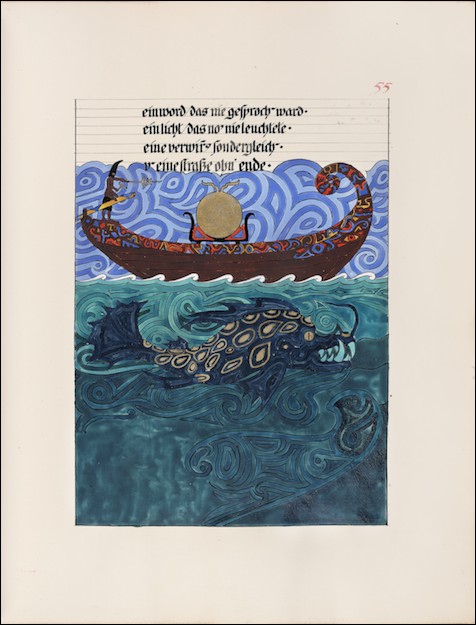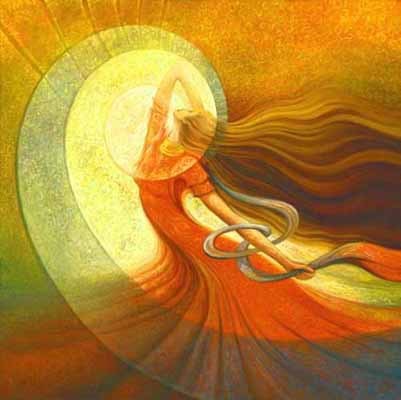
A secret book written by Carl Jung nearly one hundred years ago will be released next month according to the New York Times. Known as the “Red Book,” it was jealously guarded by Jung’s descendants until it was recently found in a bank vault and negotiations with the Jung family ultimately permitted its publication.
The work of Carl Jung transformed the field of modern psychology by incorporating the concept of archetypes and synchronicity into the mystery of the workings of the psyche. The Jungian process involves delving into our dreams and the symbols that weave a web linking the conscious and the subconscious. In doing so, we are able to venture on a path of self-discovery and facilitate the process of what Jung called “individuation” in which lost parts of ourselves are recaptured.
Jung’s awareness of the synchronicities in life incorporated the use of dreams, ancient symbols and archetypes, alchemical symbolism, and astrology. He wrote:
“The collective unconscious appears to consist of mythological motifs or primordial images, for which reason the myths of all nations are its real exponents. In fact the whole of mythology could be taken as a sort of projection of the collective unconscious. We can see this most clearly if we look at the heavenly constellations, whose originally chaotic forms are organized through the projection of images. This explains the influence of the stars as asserted by astrologers. These influences are nothing but unconscious instrospective perceptions of the collective unconscious.”
from Jung’s lecture “The Archetypes and the Collective Unconscious,” Collected Works.
In 1913 Jung “found his psyche starting to teeter and slide, until finally he was dumped into what would become a life-altering crisis.” He began experiencing visions and hearing voices, and in what he later called a confrontation with the unconscious he used the experience to attempt to tear down the wall between his rational self and his psyche. “He found himself in a liminal place, as full of creative abundance as it was of potential ruin, believing it to be the same borderlands traveled by both lunatics and great artists.” Quotations from the New York Times article.
Carl Jung’s birthchart reveals his extraordinary connection to the archetypes of the unconscious. His Sun was in the sign of Leo, reflecting the ultimate need for self-expression and self-understanding. His Sun was angular, sitting right on the cusp of the seventh house of partnership (or Descendant), suggesting that he defined himself through the Other. His Leo Sun was therefore exactly opposed to his Aquarius ascendant which requires the transcendence of the Self into an experience of the Collective.
With Aquarius on the ascendant, Jung’s chart was ruled by both Saturn (the traditional ruler) and Uranus (the modern ruler). This is a complex combination because those two planets are so different, and it gives the Aquarian nature a double-edged sword. On the one hand there is a need for order and discipline with Aquarius under Saturn, but the Uranian influence gives Aquarius its love for the unconventional and the embrace of the collective. With the Leo Sun exactly opposite the Aquarius ascendant Jung would have been torn between the individuation, as he put it, of his Selfhood (Leo), and the sublimation of individual consciousness into the mythology and symbology of the collective (Aquarius).
Angular planets are more significant in the birthchart, and Jung’s Sun was angular because it sat right on the angle called the descendant at the seventh house. His sun formed an exact square to Neptune, the planet of dreams and the subconscious, fantasy and illusion. Neptune was also angular, sitting right at the cusp of the fourth house of home and inner life, the point that we call the Nadir or the Imum Coeli. Neptune at this point brings an intimate connection with the our ancestral past that transcends the boundaries of ordinary reality. Any planet found at the Nadir of the chart affects our inner world and our very sense of being incarnated in a body, and Neptune at this point suggests a tenuous anchor between body and spirit. Neptune, like the Sun, formed a square to Jung’s ascendant, which exacerbated the thinness of the veil between Jung’s conscious Self and the subconscious and transcendent (Neptune).
The square from Neptune to the Sun has been a topic of great debate over the past couple of years because we find this aspect in the chart of President Obama. Because Neptune has a tendency to blur boundaries and confuse the issue, when it forms a challenging aspect like the square to the Sun, which represents the development of the Self and the Ego, there is a challenge to the formation of that sense of individuality. We already see that with the Sun sitting on the descendant, the point of the Other, Jung has a tendency to lose himself. The square from Neptune exacerbates this.
At the time Jung descended into his journey of darkness, transiting Uranus was crossing the ascendant of his chart and setting off this whole dynamic that challenged his Selfhood. I’ll cover this in Part II tomorrow.

